Back in the 90s when 400cc four-cylinder sportsbikes were the thing, I was busy avoiding homework and school detention. Then when I got my licence in 2002 I was too busy putting road tyres on my XR600 to get involved with sportsbikes. Looking back, it was a golden age of racing and tearing up twisty mountain roads. The 400s were weapons on a tight track or road but then they sadly went the way of the Dodo.
When the re-invented Kawasaki ZX-4R and higher-spec ZX-4RR were released, I was keen to get my butt on one to see what I had missed out on all those years ago. AMCN had already tested it on the racetrack, so it was time to see how it handles life on the road.
Rolling into Kawasaki HQ, I spotted a nice ZX-10R out the front. I parked next to it and as I took my helmet off I spied the ZX-4RR sticker on the side fairing. I couldn’t believe that I had been fooled by the big bike looks. This isn’t your run-of-the-mill LAMS 400cc twin or single cylinder; it is a real-deal four-pot screamer that is not LAMS approved and its appearance reflects that. 
It simply looks fantastic. It has twin front discs, a proper-looking exhaust system, a stiff WorldSBK-inspired frame and a trick-looking swingarm. Kawasaki has also fitted it up with sport-focused tyres, good suspension, a two-way quickshifter and a go-fast colour scheme. It is a dream come true for an aspiring racer or trackday enthusiast. But most owners will need or want to ride it on the road regularly also, so let’s hit it.
Switching on the key brings the full-colour TFT dash into life, a dash that wouldn’t look out of place on the top-spec ZX-10RR or even one of the H2 models. It is functional and beaut to look at while providing all the necessary information.
Hit the starter button and the tiny 57mm pistons start doing their thing. It is pretty quiet even though it idles at 2000rpm.
It’s hard to fathom just how small the internal engine parts are but those pistons only move 39mm from top to bottom. It makes me think of the inside of an analogue watch. Bear in mind there was once a four-cylinder ZXR250R with 49mm pistons, so Kawasaki wouldn’t have batted an eyelid at the 400’s during design.
Engage first gear and the baby Ninja will pull away slowly with surprisingly little throttle input. But if you want to move away at any sort of traffic-beating pace, you will need to dial up a few more revs, in the vicinity of 8000rpm. Which takes a little getting used to after riding big bikes. I find myself cruising the suburbs at 40km/h in sixth gear and it is as smooth as silk with zero protest from the engine – it just purrs along – but don’t bother trying to accelerate quickly from those revs. There is simply nothing on offer from the rev-happy engine in the low end of the tacho.
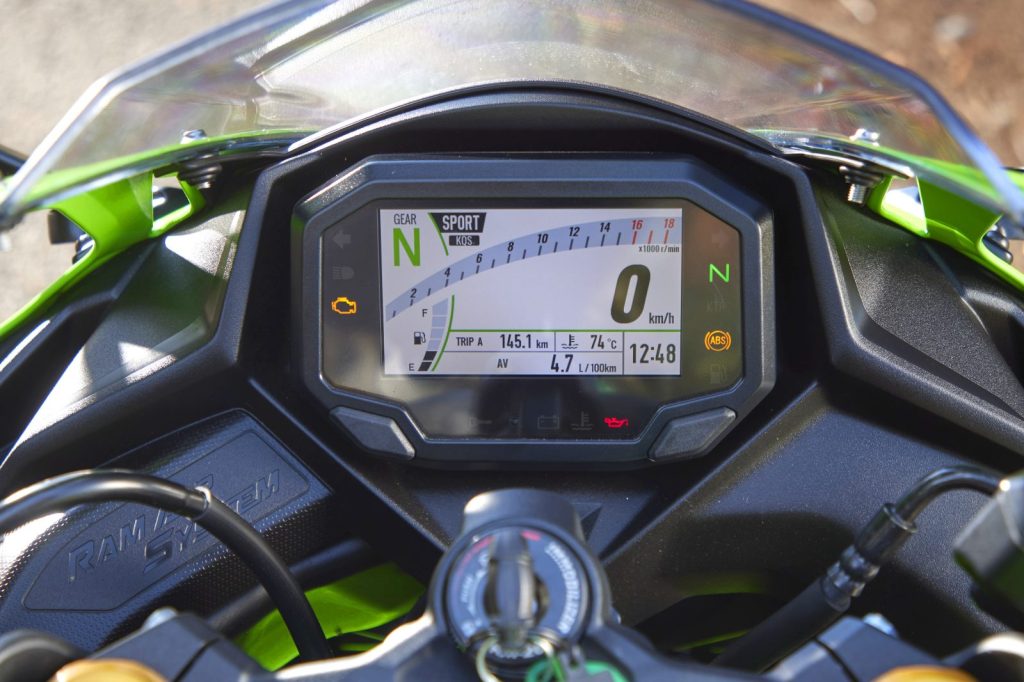
Letting the 400 spread its wings and rev out, however, is an aural delight. It sounds just like a ZX-6R but without the police sirens as you rev out second gear on the road. The induction wail from the ram-air intake is trademark Kawasaki and just awesome. Using all the rev range soon becomes addictive as the torque peaks at about 12,500rpm. You can feel the torque die off after that while the revs happily keep rising all the way to 15,500rpm.
To get the most out of the engine you need to disengage your mechanical sympathy and just send it. It doesn’t do anything unpredictable like pull wheelies etc., it just makes noise and builds speed progressively.
I can’t help but feel a little self-conscious as pedestrians turn and look at what is screaming its head off expecting a bike doing warp speed, but there’s me barely breaking the speed limit getting ahead of the cars from the lights. I think the little Ninja attracts more attention than just about any other bike I’ve ridden thanks to the screaming induction noise. People must hear it a mile away.
While taking some happy snaps a couple of kids even came over and asked to hear it rev. I let them give the throttle a twist and it made their day. I can’t even imagine how it would sound with a full titanium racing exhaust system. It would be criminal. Tucking in and ripping down backroads feels like I’m racing in the North West 200 but barely breaking the national speed limit while clicking up and down through the gearbox with the standard-fitment quickshifter.
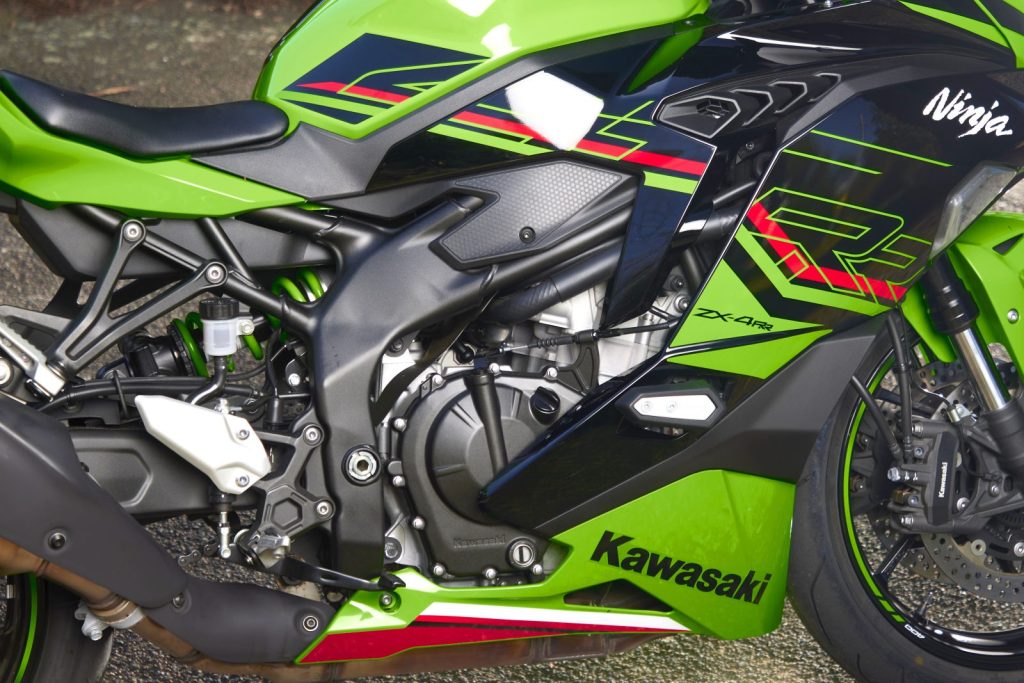
Commuting to and from work, the 400 slices through gaps like a Ninja, if you are in the right gear. Best not to get caught napping low in the rev range if you want to jump into a gap as you will be disappointed with the 400’s available torque. But if you keep the revs up over 8000rpm it’s smooth sailing. The 400 is super chill at highway speeds with no bad manners. I am delightfully impressed.
The quickshifter isn’t perfect but it’s not far off. I feel that I could shift quicker up through the gears without it as the ‘cut’ time is a bit too long when high in the rev range. But cruising lower in the revs it’s pretty good. Downshifting is bliss at any speed. A firm click down on the shifter and the engine blips the perfect amount to engage the lower gear.
The little Ninja also has a slipper clutch but it’s hardly noticeable besides a gentle pulse through the clutch lever if you are resting your fingers on it. The clutch is a cable-operated slip-and-assist type, making it very light to operate with good feel. Bonus points are awarded for span-adjustable levers, too. But don’t make plans on backing it in supermoto style as the ABS is non switchable.
As you would expect from a small sportsbike, the handling is swift and precise as the chassis geometry is derived from the multiple world championship winning ZX-10RR. It isn’t really as light as you might expect at 188kg wet, but it doesn’t feel like it’s carrying excess baggage. the 400 tips into corners almost as fast as you can think about turning and holds a line ferociously – the way it hugs a turn is just epic, I have to recalibrate my brain to keep up my momentum and simply chuck it into corners to try and push its limits. It just keeps asking for more as it loves corners.
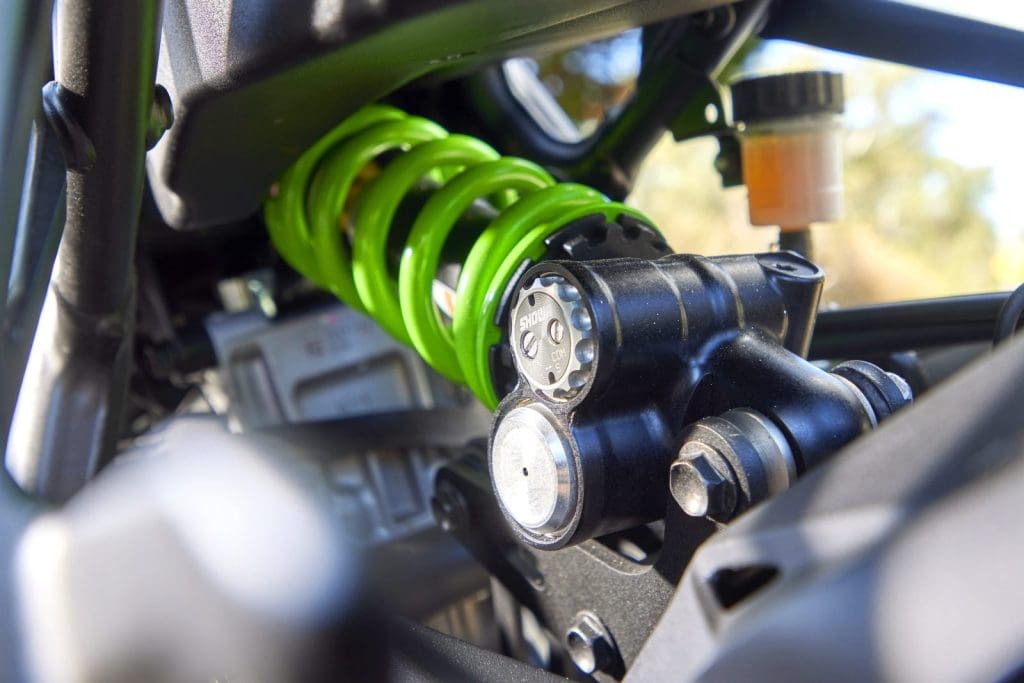
With the high-revving engine you get the most out of the package by keeping corner speeds up and the revs high flowing from one corner to the next. The suspension is up for it, too. The ZX-4RR is equipped with a preload-adjustable, 37mm separate function, big-piston Showa fork and a horizontal rear linkage with a BFRC lite Showa shock. That stands for Balance Free Rear Cushion. The same spec equipment as found on a ZX-10RR, it has adjustable preload, rebound and compression damping. While I am way above the weight the little Ninja is designed for, I find the suspension more than capable of coping with my antics. Yes, it is a bit squishy, but I’m safely 25kg heavier than the weight of the expected rider. The suspension is designed for sporty performance above comfort, and I think it is a good balance between the two.
Braking performance is exceptional. Dual 290mm discs up front are grabbed by four-piston monobloc calipers that wouldn’t be out of place on a 1000cc bike. Rubber brake lines are utilised, which I usually detest, but in this case with a light and nimble bike it takes the edge off what could be some pretty aggressive brakes. One finger braking is all that is needed.
The electronics suite is impressive for a 400cc machine with four modes available in Sport, Road, Rain and Rider. Rider is a customisable mode where you can choose from three throttle maps and three traction control settings as well as off. There is no option for ABS switching, which is a bit of a bummer for a track-focused bike.
I spend most of my time in the Sport mode as it gives full power with the best throttle response and, let’s face it, the power output isn’t aggressive enough to warrant softening. The traction control is very unobtrusive as the bike doesn’t wheelie or break traction generally. I only noticed it kick in once with a heavy throttle hand across some poor quality bitumen while leant over causing the rear to skip a bit and the TC to cut in. So it is nice to know it is there if you need it.
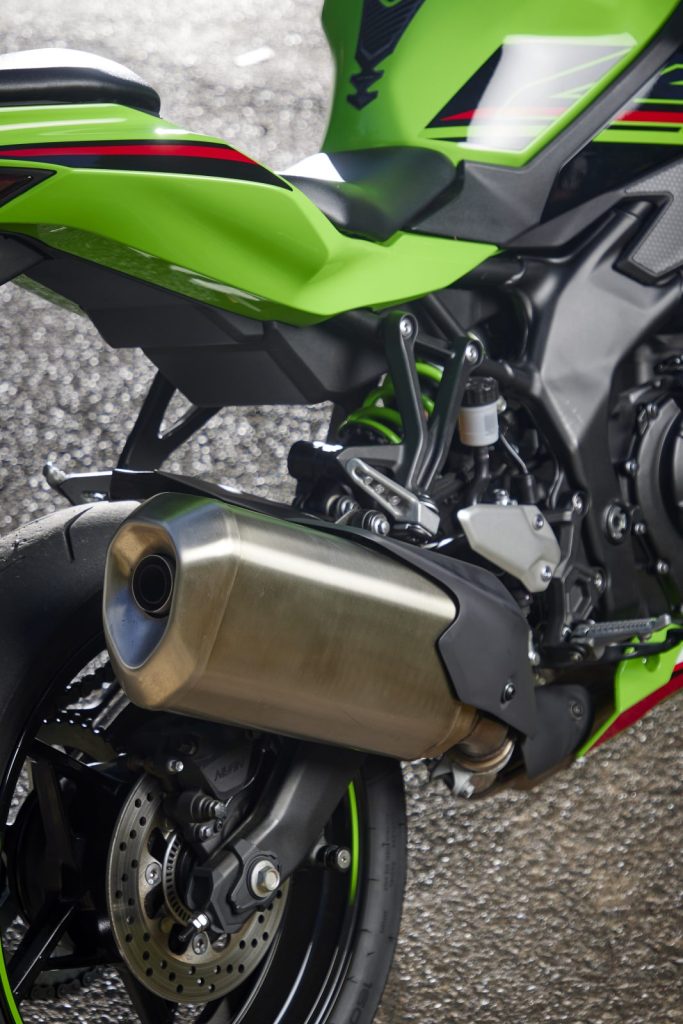
The ZX-4RR is surprisingly roomy. It feels similar in size to a 600cc Supersport machine but a little lower to the ground and, of course, it’s lighter. An 800mm seat height makes it really accessible and the reach to the ’bars isn’t too long so there isn’t a heap of weight going through your wrists, even though the riding position is quite sporty.
I did bump my knee on the handlebar while doing a feet-up full-lock U-turn. There is no way in hell I can tuck in behind the tiny screen but it is a nice gesture by Kawasaki to have it clear in case someone else can get down that low on it and still see where they are going. Aside from the tiny screen, I can’t get past how comfortable it is given my 100kg and 178cm chassis.
The Ninja has full LED lighting. Normally sportsbike headlights are form over function but I found while commuting in the dark that these are excellent. Fuel range is pretty good at over 300km per tank, in theory. I got 260km and only put 11.9L in to the 15L tank, so range is more than enough for commuting or a decent day out in the country in search of deserted twisty roads.
As you can see, the ZX-4RR isn’t your average small-capacity sportsbike. It is built from the ground up with quality components and a focus on performance rather than price.
It’s a case of horses for courses and this little ripper won’t suit everyone. But if you’re keen to have a trackday-capable bike with world championship-winning pedigree you will see the value in the $15k price tag. It is not a learner bike, it is a pint-sized superbike.
PROS: Nimble handling, screaming four-cylinder engine and it’s surprisingly comfortable.
CONS: No LAMS option for newbies, no class to race it in and expensive for the capacity.
WORDS: DAVID WATT PHOTOS: JOSH EVANS
DIGITAL COMMUNICATIONS
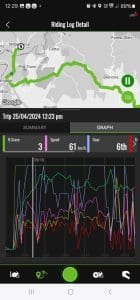
The 4.3-inch TFT colour dash takes pride of place in the cockpit. Worthy of much higher-spec bikes, it displays a magnitude of information. In track mode it focuses on lap time and the tacho between 10,000rpm and 15,000rpm. It self-adjusts for brightness and can run either a white or black background.
The ZX-4RR is also Bluetooth compatible out of the box. Hook up your smartphone with the Kawasaki Rideology app and track your rides and maintenance information. The data log of your ride shows RPM, gear position, water temp and speed. It lays it over a map or by graph. When your phone is hooked up you can receive notifications and answer calls through the bike’s dash. Under the passenger seat there is a USB power outlet for charging on the go.
COUNTING YOUR ARGHS
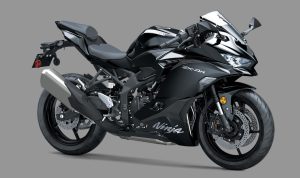
If the thought of shelling out $15,000 to ride away on the RR has you a little apprehensive, the entry-point ZX-4R can be had for about $13,500 ride away. Obviously you miss out on a few trick bits but the fun level will still be high.
The ZX-4R doesn’t have the KRT-inspired green paint and is available in metallic black only. The front fork is the lower-spec unit without preload adjustment, while the rear shock is non-adjustable. The R also misses out on the two-way quickshifter. For most, these are not deal-breaking items, so save yourself some dollars for new gear to hit the track with if you like.
SPECIFICATIONS – KAWSAKI NINJA ZX-4RR
ENGINE
Capacity 399cc
Type Inline-four, four valves per cylinder
Bore & stroke 57 x 39.1mm
Compression ratio 12.3:1
Cooling Liquid
Fueling EFI
Transmission Six-speed
Clutch Wet, multi-plate, slipper
Final drive Chain
PERFORMANCE
Power 56.7kW (76hp) @ 14,500rpm (claimed)
Torque 37.6Nm @ 12,500rpm (claimed)
Top speed 210km/h (est)
Fuel consumption Not measured
ELECTRONICS
Type Kawasaki
Rider aids ABS, traction control, quickshifter
Rider modes Track, Sport, Rain or Rider
CHASSIS
Frame material Steel
Frame type Trellis
Rake 23.5°
Trail 97mm
Wheelbase 1380mm
SUSPENSION
Type Showa
Front: 37mm Showa SFF-BP USD fork, preload adjustment, 120mm travel
Rear: Showa BFRC Lite monoshock, fully adjustable, 124mm travel
WHEELS & BRAKES
Wheels five-spoke alloy
Front: 17 x 3.5 Rear: 17 x 4.5
Tyres Dunlop GPR300
Front: 120/70ZR17
Rear: 160/60ZR17
Brakes Kawasaki, ABS
Front: Twin 290mm discs, four-piston calipers
Rear: Single 220mm disc, single-piston caliper
DIMENSIONS
Weight 188kg (kerb, claimed)
Seat height 800mm
Width 765mm
Height 1110mm
Length 1990mm
Ground clearance 135mm
Fuel capacity 15L
SERVICING & WARRANTY
Servicing First: 1000km
Minor: 12,000km
Major: 24,000km
Warranty Two years,
unlimited kilometres
BUSINESS END
Price $13,194 (plus on-road costs)
Colour options Lime Green/Ebony
CONTACT
www.kawasaki.com.au











